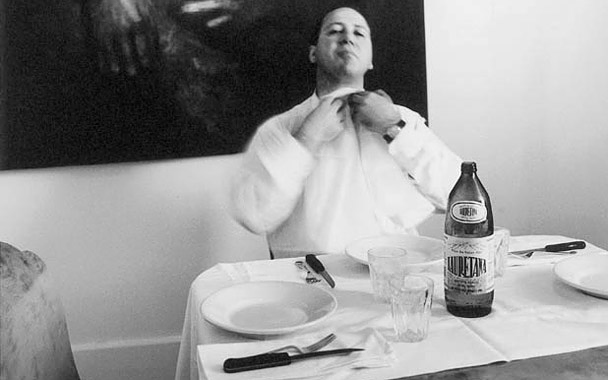On the southern banks of the Yarra—the muddy river that flows slowly through the heart of Melbourne—a modern saga is unfolding. It’s an entertainment complex called Crown. Vegas in microcosm. Along with the hotels, shops, bars, nightclubs, and, of course, Crown Casino—the jewel in the revenue tiara—the landlord is remorselessly driving a swath of restaurants upmarket and kicking out any tenants who can’t live up to the place’s blue-chip image.
In 2006, Neil Perry became the first big-name Australian chef to open a restaurant at Crown with the launch of Rockpool Bar & Grill. It’s been a critical and commercial success, and the food—some of the country’s best seafood sharing equal billing with grass-fed, dry-aged steaks—is terrific. The following year, Crown reveled in the prestige of having its own Nobu, a first on this side of the world. But despite the hype, the multimillion-dollar investment, and the visits by Nobu-san, Robert De Niro, and friends, Nobu has faded from the town’s dining spotlight faster than an aging starlet after a face-lift gone wrong. It will be interesting to see what happens when Crown gets its very own Gordon Ramsay outpost next year, also a first in the Southern Hemisphere.
Ours is a tough, skeptical city when it comes to restaurants. Down here, nothing succeeds solely on the back of a brand. In Melbourne, it’s all about one thing: the food.
Still, it’s hard not to compare Melbourne with Sydney, and the second-city syndrome is part of Melbourne’s identity. Sydney may have the beaches, the climate, the high-end restaurants with million-dollar views. But never mind all that, say Melbourne’s residents: We spread the love around. We may have fewer three-star establishments, but we’re proud of our greater range, from smart, contemporary bistros down to grassroots joints that reflect the town’s diverse makeup. Plus, our network of inner-city produce markets, led by the Queen Victoria, is the envy of our northern rival. The upside to a notoriously fickle “temperate” climate is the strength of our nearby wine regions, many within an hour’s drive of the capital. We have the reputation across Australia as the go-to city for the echt food-and-wine experience—and the best coffee, too.
“I think Melbourne has a greater population of what I’d call ‘professional diners’ than Sydney does,” says Neil Perry. “Sydney is a much brasher, faster city, but Melbournians are more relaxed and warm, and they get a huge amount of enjoyment from dining out. They’re very savvy about food and wine, and they’re better food critics.”
The cobblestoned lanes that crisscross the city’s core business district are where you’ll find the places that typify Melbourne’s more casual approach to eating and drinking. Places like Bar Lourinhã, the Iberia-meets–New World home of chef Matt McConnell, where aficionados throng high communal tables to enjoy the likes of kingfish “pancetta” with lemon oil. Or his big brother Andrew’s white-hot café-cum-bar, Cumulus Inc., where a Macedon Pinot Noir matches up blissfully with a house-made boudin noir with smoked tomato. Trunk, located in a building that was one of Melbourne’s first synagogues, is home tothe earthy pleasures of modern Italian food—think spaghettini with smoked eel and fried bread crumbs. And the wine-bar-with-great-food concept extends well beyond the city’s limits. In the trendy inner suburbs of Fitzroy, Carlton, South Melbourne, St. Kilda, and Brunswick East, openings have been so prolific that it has become hard for locals, let alone visitors, to keep up.
The waves of post–World War II immigration from Europe and Asia have had a tremendous impact on Melbourne’s food scene. It’s especially difficult to overestimate the influence of Italian transplants on all aspects of the city’s gastronomic culture. You see it at a 20-year-old classic, the eternally hip Café di Stasio, in St. Kilda. You drink it in every time you take an espresso shot from one of hundreds of Italian coffee roasters based in the northern suburbs. You taste it in a glass of Sangiovese or Nebbiolo from Victoria’s King Valley region, where a generation of Italian tobacco growers gave up the leaf for the grape to subsequent acclaim. And at Sarti, Riccardo Momesso—a man who hunts wild boar to make his own lardo, salsiccia, and prosciutto—distills the city’s unquenchable love affair with all things Italian to produce delicate, inspired dishes like Wagyu carpaccio with porcini zabaglione.
Melbournians looking for cheap and cheerful Vietnamese restaurants and exotic, bargain-basement food shopping that is strikingly reminiscent of Saigon itself head to Richmond, a ten-minute drive from the city. Of the many spots dedicated to pho, perhaps the best is Chu The, where a deeply flavored bowl of the famous rice-noodle soup will set you back a whole $5. Minh Minh augments its Vietnamese standards with some powerfully chile-spiked Laotian food—fun, but not for the faint-hearted. Melbourne’s African food presence is dominated by Ethiopian immigrants, and most have set up shop in or around the inner suburb of Footscray. On the fringe, The Abyssinian serves both Ethiopian and Eritrean slow-cooked dishes that are a notch above most, and the value for money is unquestionable.



 Pinterest
Pinterest






